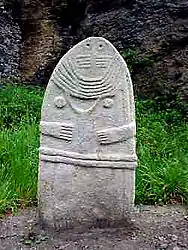.jpg.webp)
A statue menhir is a type of carved standing stone created during the later European Neolithic Period.
The statues consist of a vertical slab or pillar with a stylised design of a human figure cut into it, sometimes with hints of clothing or weapons visible.
Locations
They are most commonly found in southern and western France, Catalonia,[1] Corsica, Sardinia, Italy and the Alps. A group from the Iron Age also is known in Liguria and Lunigiana.
There are two in Guernsey,[2] La Gran' Mère du Chimquière ('the Grandmother of the Cemetery'), a highly detailed example in the churchyard of Parish of Saint Martin, and another known simply as La Gran' Mère in the Parish of Castel. The latter is an earlier, less detailed example found buried underneath the porch of the parish church.
 Statue-menhir la Dame de Saint-Sernin, musée Fenaille de Rodez
Statue-menhir la Dame de Saint-Sernin, musée Fenaille de Rodez Statue menhir of Paillemalbiau (Murat-sur-Vèbre)
Statue menhir of Paillemalbiau (Murat-sur-Vèbre) Statue menhir of Laconi, Sardinia
Statue menhir of Laconi, Sardinia
See also
References
- ↑ Estàtua-menhir Archived 2014-07-20 at the Wayback Machine
- ↑ Evendon, J (2001-02-11). "Le Dehus - Burial Chamber (Dolmen)". The Megalithic Portal. Retrieved 2008-09-16.
External links
Further reading
- Maillé, M. 2010 - Hommes et femmes de pierre, Statues-menhirs du Rouergue et du Haut Languedoc, AEP, monographie, 538 pages, 2010.
- Martínez, P.; Fortó, A. Rufo, V. 2010, La estatua-menhir de Ca l'Estrada (Canovelles, Barcelona), una representación con elementos del grupo figurativo de la Rouergue (Aveyron, Francia), Munibe suplemento 32 |data =2007 |pàgines = p. 498-505 |lloc =Beasain.
- Martínez, P. 2011, La estatua-menhir del Pla de les Pruneres (Mollet del Vallès) Complutum, 2011, Vol. 22 (1): 71–87. Universidad Complutense de Madrid. Madrid.
- Moya, A.; Martínez, P.; López, J.B. 2010, Èssers de pedra. Estàtues-menhirs i esteles antropomorfes a l'art megalític de Catalunya Cypsela núm 18, pp 11–41. Museu d'Arqueologia de Catalunya, Girona.
- Servelle, Ch. 2009 - « Étude pétroarchéologique et technologique de la statue-menhir du Baïssas, Le Bez, Tarn », Archéologie Tarnaise, n° 14, 2009, p. 115-121, 4 fig.
- Vaquer, J. et Maillé, M. 2011 - « Images de guerrier au Néolithique final - Chalcolithique dans le midi de la France : les poignards – figurations sur les statues-menhirs rouergates et objets réels », in L’armement du guerrier dans les sociétés anciennes : de l’objet à la tombe, Actes de la table ronde internationale et interdisciplinaire, Sens, CEREP, 4 juin 2009. Dijon, éd. universitaires de Dijon, p. 103-120.